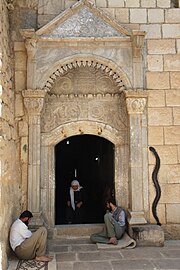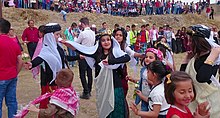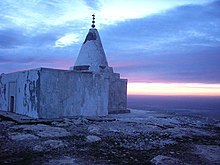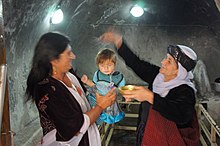Yazidism
This article needs additional citations for verification. (June 2022) |
| Yazidism Êzdiyatî ئێزدیتی | |
|---|---|
Hazim Tahsin or Naif Dawud[3] | |
| Baba Sheikh | Sheikh Ali Ilyas[4] |
| Language | Kurmanji (Kurdish) |
| Headquarters | Lalish |
| Origin | 12th century Kurdistan |
| Members | c. 1,000,000–1,500,000[5][6] |
| Other name(s) | Şerfedîn |
 |
| Part of a series on the Yazidi religion Yazidism |
|---|
 |
Yazidism,
History
Principal beliefs
Yazidis believe in one God, whom they refer to as Xwedê, Xwedawend, Êzdan, and Pedsha ('King'), and, less commonly, Ellah and Heq.
Tawûsî Melek


The Yazidis believe in a divine Triad.[7][18][24] The original, hidden God of the Yazidis is considered to be remote and inactive in relation to his creation, except to contain and bind it together within his essence.[7] His first emanation is Melek Taûs (Tawûsî Melek), the Peacock Angel, who functions as the ruler of the world.[7][18][24] The second hypostasis of the divine Triad is the Sheikh 'Adī. The third is Sultan Ezid. These are the three hypostases of the one God. The identity of these three is sometimes blurred, with Sheikh 'Adī considered to be a manifestation of Tawûsî Melek and vice versa; the same also applies to Sultan Ezid.[7] Yazidis are called Miletê Tawûsî Melek ("the nation of Tawûsî Melek").[25]
Yazidis, however, believe Tawûsî Melek is not a source of evil or wickedness.[7][18][24] They consider him to be the leader of the archangels, not a fallen angel.[7][24][26][27]
The Yazidis of Kurdistan have been called many things, most notoriously 'devil-worshippers', a term used both by unsympathetic neighbours and fascinated Westerners. This sensational epithet is not only deeply offensive to the Yazidis themselves, but quite simply wrong.[31] Non-Yazidis have associated Melek Taûs with Shaitan (Islamic/Arab name) or Satan, but Yazidis find that offensive and do not actually mention that name.[31]
Holy figures
Yezidis believe in Seven Angels, considered the
The
Sheikh 'Adī

One of the important figures of Yazidism is
Rebirth and concept of time
Yazidis believe in the rebirth of the soul. Like the Ahl-e Haqq, the Yazidis use the metaphor of a change of garment to describe the process, which plays an exceptional role in Yazidi religiosity and is called the "change of [one's] shirt" (kirasgorîn). There is also a belief that some of the events from the time of creation repeat themselves in cycles of history. In Yazidism, different concepts of time coexist:[10]
- An esoteric time sphere (Kurdish: enzel), This term denotes a state of being before the creation of the world. According to Yazidi cosmogony, there is God and a pearl in this stage.
- Bedîl or dewr (a cyclic course of time): it means literally 'change, changing' or 'turning, revolution' and in the Yazidi context denotes a new period of time in the history of the world. Therefore, it may also mean 'renewing' or 'renewed' and designates the start of a renewed period of time.
- A linear course, which runs from the start of the creation by God to the collective eschatological end point.
- Three tofan ('storm, flood') i.e. catastrophes. It is believed that there are three big events during history named tofan that play a purificatory role, changing the quality of life in a positive manner. Each catastrophe, which ultimately brings renewal to the world, takes place through a basic element: the first through water (tofanê avê), the second through fire (tofanê agirî) and the last is connected with wind (air) (tofanê ba). It is believed that the first tofan has already occurred in the past and that the next tofan will occur through fire. According to this perception, the three sacred elements, namely water, fire and air, purify the fourth one, the earth. These events however are not be considered as eschatological events. They occur during the life of people. Although the purificatory events cause many deaths, ultimately life continues.[46]
In Yazidism, the older original concept of metempsychosis and the cyclic perception of the course of time is harmonised and coexists with the younger idea of a collective eschatology.[10]
Cosmogony and beginning of life
The Yazidi cosmogony is recorded in several sacred texts and traditions. It can therefore only be inferred and understood through an overall view of the sacred texts and traditions. The cosmogony can be divided into three stages:
- Enzel – the state before the pearl burst (dur).
- Developments immediately after the burst – cosmogony II
- The creation of the earth and man – anthropogony[47][48]
The term Enzel is one of the frequently mentioned terms in the religious vocabulary and it comes up numerous times in the religious hymns, known as Qewls. For instance, in Qewlê Tawisî Melek:
"Ya Rebî ji Enzel de her tuyî qedîmî" (English: Oh, Creator of the Enzel, you are infinite)[49]
And Dûa Razanê:
Ezdayî me, ji direke enzelî me (English: I am a follower of God, I come from an "enzelî" pearl)[49]
Thus, the term Enzel can also be referred to as a "pure, spiritual, immaterial and infinite world", "the Beyond" or "the sphere beyond the profane world". The Enzel stage describes a spaceless and timeless state and therefore illustrates a supernatural state. In this stage, initially there is only a God, who creates a pearl out of his own light, in which his shining throne (textê nûrî) is located.
Qewlê Bê Elif:
Padşê min bi xo efirandî dura beyzaye – My King created the white pearl from himself
Textê nûrî sedef – The shining throne in the pearl[49]
The Yazidi
The Yazidi religion has its own perception of the colours, which is seen in the mythology and shown through clothing taboos, in religious ceremonies, customs and rituals. Colours are perceived as the symbolizations of nature and the beginning of life, thus the emphasis of colours can be found in the creation myth. The colors white, red, green and yellow in particular are frequently emphasized. White is considered the color of purity and peace and is the main colour of the religious clothing of the Yazidis.[50][2][48]
Yazidi accounts of the creation differ significantly from those of the Abrahamic religions (Judaism, Christianity, and Islam), since they are derived from the Ancient Mesopotamian and Indo-Iranian traditions; therefore, Yazidi cosmogony is closer to those of Ancient Iranian religions, Yarsanism, and Zoroastrianism.[51][52]
Yazidi sacred texts
This section needs additional citations for verification. (June 2022) |
The religious literature of Yazidis is composed mostly of poetry which is orally transmitted in mainly Kurmanji and includes numerous genres, such as Qewl (religious hymn), Beyt (poem), Du‛a (prayer), Dirozge (another kind of prayer), Şehdetiya Dîn (the Declaration of the Faith), Terqîn (prayer for after a sacrifice), Pişt perde (literally 'under the veil', another genre), Qesîde (Qasida), Sema‛ (literally 'listening'), Lavij, Xerîbo, Xizêmok, Payîzok, and Robarîn. The poetic literature is composed in an advanced and archaic language where more complex terms are used, which may be difficult to understand for those who are not trained in religious knowledge.[citation needed] Therefore, they are accompanied by some prosaic genres of the Yazidi literature that often interpret the contents of the poems and provide explanations of their contexts in the spoken language comprehensible among the common population. The prosaic genres include Çîrok and Çîvanok (legends and myths), and Dastan and Menal Pîrs (interpretations of religious hymns).[53][1] Yazidis also possess some written texts, such as the sacred manuscripts called mişûrs and individual collections of religious texts called cilvê and Keşkûl, although they are rarer and often safekept among Yazidis.[54] Yazidis are also said to have two holy books, Book of Revelation and Black Book whose authenticities are debated among scholars.[1]
Holy books
The Yazidi
Qewl and Beyt
A very important genre of oral literature of the Yazidi community consists of religious hymns, called Qewls, which literally means 'word, speech' (from Arabic qawl). The performers of these hymns, called the Qewal, constitute a distinct class within the Yazidi society. They are a veritable source of ancient Yazidi lore and are traditionally recruited from the non-religious members of other Kurdish tribes, principally the Dumilî and Hekarî.[56][18][10] The qewls are full of cryptic allusions and usually need to be accompanied by čirōks ('stories') that explain their context.[1]
Mishur
Mishurs are a type of sacred manuscripts that were written down in the 13th century and handed down to each lineage (ocax) of the Pirs; each of the manuscripts contain descriptions of the founder of the Pir lineage that they were distributed to, along with a list of Kurdish tribes and other priestly lineages that were affiliated with the founder. The mishurs are safekept among the families of Pirs in particular places that are designated for their safekeeping; these places are referred to as stêr in Kurmanji.[57] According to the Yazidi tradition, there are a total of 40 mishurs which were distributed to the 40 lineages of Pirs.[10]
Festivals

Yazidi New Year
The Yazidi New Year (Sersal) is called Çarşema sor ("Red Wednesday")[23] or Çarşema Serê Nîsanê ("Wednesday at the beginning of April").[58] It falls in spring, on the first Wednesday[59] of the April and Nîsan months in the Julian and Seleucid calendars, i.e. the first Wednesday on or after 14 April according to the Gregorian calendar.[60][61]
Feast of Êzî

One of the most important Yazidi festivals is Îda Êzî ("Feast of Êzî"), which is celebrated in commemoration of the divine figure Sultan Ezid. Which every year takes place on the first Friday on or after 14 December. Before this festival, the Yazidis fast for three days, where nothing is eaten from sunrise to sunset. The Îda Êzî festival is celebrated in honor of God and the three days of fasting before are also associated with the ever shorter days before the winter solstice, when the Sun is less and less visible. With the Îda Êzî festival, the fasting time is ended. The festival is often celebrated with music, food, drinks and dance.[62]
Tawûsgeran
Another important festival is the Tawûsgeran, where Qewals and other religious dignitaries visit Yazidi villages, bringing the sinjaq, sacred images of a peacock symbolizing Tawûsê Melek. These are venerated, fees are collected from the pious, sermons are preached and holy water and berat (small stones from Lalish) distributed.[63][64]
Feast of the Assembly
The greatest festival of the year is the Cêjna Cemaiya ('
If possible, Yazidis make at least one pilgrimage to Lalish during their lifetime, and those living in the region try to attend at least once a year for the Feast of the Assembly in autumn.[67]
Tiwaf
Tiwafs are yearly feasts of shrines and their holy beings which constitute an important part of Yazidi religious and communal life. Every village that contains a shrine holds annual tiwafs in the name of the holy being to which the shrine is dedicated.[68][69]
Religious practices
Prayers
Prayers occupy a special status in Yazidi literature. They contain important symbols and religious knowledge connected with the Holy Men, God, and daily situations. The prayers are mostly private and as a rule they are not performed in public. Yazidis pray towards the sun,[70] usually privately, or the prayers are recited by one person during a gathering. The prayers are classified according to their own content. There are:
- Prayers dedicated to God and holy beings
- Prayers of Yazidi castes
- Prayers for specific occasions
- Rite of passage prayers
- Prayers against health problems and illnesses
- Daily prayers
- Prayers connected with the nature, i.e. the Moon, stars, Sun, etc.[53]
Purity and taboos

Many Yazidis consider pork to be prohibited. However, many Yazidis living in Germany began to view this taboo as a foreign belief from Judaism or Islam and not part of Yazidism, and therefore abandoned this rule.[72] Furthermore, in a BBC interview in April 2010, Baba Sheikh, the spiritual leader of all Yazidis, stated that ordinary Yazidis may eat what they want, but the religious clergy refrain from certain vegetables (including cabbage) because "they cause gases".[73]
Some Yazidis in Armenia and Georgia who converted to Christianity, still identify as Yazidis even after converting,[74] but are not accepted by the other Yazidis as Yazidis.[75]
Customs

Children are baptised at birth and circumcision is not required, but is practised by some due to regional customs.[76] The Yazidi baptism is called mor kirin (literally: 'to seal'). Traditionally, Yazidi children are baptised at birth with water from the Kaniya Sipî ('White Spring') at Lalish. It involves pouring holy water from the spring on the child's head three times.[77][78]
Religious organisation
The Yazidis are strictly
There are several religious duties that are performed by several dignitaries, such as the Mir Hejj (Prince of the Pilgrimage), Sheikh el-Wazir (who oversees the sanctuary of Sheikh Shems at Lalish), Pire Esbiya (treasurer of the sanctuary of Sheikh Shems at Lalish), Mijewir (local shrine custodian), Baba Chawush (guardian of the sanctuary of Sheikh Adi), and others.[21]
See also
- List of Yazidi holy places
- List of Yazidi saints
- List of Yazidi settlements
- Persecution of Yazidis by Muslims
References
- ^ from the original on 17 November 2016. Retrieved 9 January 2022.
- ^ ISBN 978-0-7734-9004-8.
- ^ "Yezidis divided on spiritual leader's successor elect rival Mir".
- ISSN 0013-0613. Retrieved 2021-01-08.
- ISBN 978-1-5011-9917-2.
- ^ "Aziz Tamoyan blames unknown forces for crippling history and culture of Yazidis". armenpress.am. Retrieved 2021-01-10.
- ^ OCLC 931029996.
- ISBN 978-0-415-07265-6.
- ^ "مهزارگههێ شهرفهدین هێشتا ژ ئالیێ هێزێن پێشمهرگهی ڤه دهێته پاراستن" (in Kurdish). Retrieved 29 December 2019.
- ^ OCLC 994778968.
- ISBN 978-1-904584-60-5.
- ISBN 978-1-904584-90-2.
- ISBN 978-1-56432-552-5.
- ISBN 978-0-429-96271-4.
- .
- OCLC 879288867. (2) Kaczorowski, Karol (2014). "Yezidism and Proto-Indo-Iranian Religion". Fritillaria Kurdica. Bulletin of Kurdish Studies (3–4). (3) Foltz, Richard (2017-06-01). "The "Original" Kurdish Religion? Kurdish Nationalism and the False Conflation of the Yezidi and Zoroastrian Traditions". Journal of Persianate Studies. 10 (1): 87–106.ISSN 1874-7094. (4) Omarkhali, Khanna (2009–2010). "The status and role of the Yezidi legends and myths: to the question of comparative analysis of Yezidism, Yārisān (Ahl-e Haqq) and Zoroastrianism: a common substratum?". Folia Orientalia. 45–46: 197–219.OCLC 999248462. (5) Kreyenbroek, Philip G. (1995). Yezidism--its Background, Observances, and Textual Tradition.ISBN 978-0-7734-9004-8.
- ^ ISBN 9780857720610.
- ^ ISBN 9780199340378. Archivedfrom the original on 11 March 2019. Retrieved 15 May 2021.
- ^ ISBN 9780739177754.
- ^ Omarkhali, Khanna (December 2009). "Names of God and Forms of Address to God in Yezidism. With the Religious Hymn of the Lord". Manuscripta Orientalia International Journal for Oriental Manuscript Research. 15 (2).
- ^ OCLC 63127403.
- ISBN 9783828864887.
- ^ OCLC 233145721.
- ^ OCLC 233145721.
- ISBN 978-1-317-54428-9.
- ^ OCLC 919303390.
- ^ OCLC 888467694.
- ^ Li, Shirley (8 August 2014). "A Very Brief History of the Yazidi and What They're Up Against in Iraq". The Atlantic.
- ^ Jalabi, Raya (11 August 2014). "Who are the Yazidis and why is Isis hunting them?". The Guardian.
- ^ Thomas, Sean (19 August 2007). "The Devil worshippers of Iraq". The Daily Telegraph. Archived from the original on 2022-01-12.
- ^ a b Allison, C. (1998). "The Evolution of the Yezidi Religion. From Spoken Word to Written Scripture" (PDF). The Evolution of Yezidi Religion - From Spoken Word to Written Scripture. Vol. 1. ISIM, Leiden. p. 14.
{{cite book}}:|website=ignored (help) - ^ a b Spät, Eszter (2009). "Late Antique Motifs in Yezidi Oral Tradition" (PDF). Central European University. p. 71.
- ISBN 978-0-415-07265-6.
- ISBN 978-5-905016-967.
- ^ Murad, Jasim Elias (1993). The Sacred Poems of the Yazidis: An Anthropological Approach. University of California, Los Angeles.
- ISBN 978-0-7734-9004-8.
- ISBN 978-1-350-14927-4.
- ISSN 2051-4891.
- S2CID 246596953.
- ^ Late Antique Motifs in Yezidi Oral Tradition by Eszter Spät. Ch. 9 "The Origin Myth of the Yezidis" section "The Myth of Shehid Bin Jer" (p. 347)
- S2CID 247034058, retrieved 2022-03-08
- OCLC 879288867.
- ^ Kaczorowski, Karol (2014). "Yezidism and Proto-Indo-Iranian Religion". Fritillaria Kurdica. Bulletin of Kurdish Studies (3–4).
- ISSN 1874-7094.
- OCLC 999248462.
- OCLC 1120653126.)
{{cite book}}: CS1 maint: multiple names: authors list (link) CS1 maint: numeric names: authors list (link - ^ Franz, Erhard (2004). "Yeziden - Eine alte Religionsgemeinschaft zwischen Tradition und Moderne" (PDF). Deutsches Orient-Institut.
- ^ a b Omarkhali, Khanna; Rezania, K. (2009). "Some reflections on the concepts of time in Yezidism". In Christine Allison; Anke Joisten-Pruschke; Antje Wendtland (eds.). From Daēnā to Dîn Religion, Kultur und Sprache in der iranischen Welt.
- ^ a b c Авдоев, Теймураз (2020). NEWŞE DÎNÊ ÊZÎDIYAN ЕЗИДСКОЕ СВЯЩЕНОСЛОВИЕ THE YEZIDI HOLY HYMNES.
- ^ "Schöpfungsmythos – Êzîpedia" (in German). Retrieved 2021-06-07.
- ISBN 9781780743097p. 221
- ^ Omarkhali, Khanna (2009–2010). "The status and role of the Yezidi legends and myths. To the question of comparative analysis of Yezidism, Yārisān (Ahl-e Haqq) and Zoroastrianism: a common substratum?". Folia Orientalia. 45–46.
- ^ ISSN 1817-7530.
- ISBN 978-3-319-93087-9.
- ^ ""Devil worship"; the sacred books and traditions of the Yezidiz" (PDF).
- ^ Cheung, Johnny. "Qewl | Yezidi Stories". Retrieved 2021-06-02.
- S2CID 214483496.
- ISBN 9785040433988.
- S2CID 211672629.
- ^ "Das êzîdîsche Neujahr" (PDF).
- S2CID 243594800.
- ISBN 9783170359383.
- ISBN 9783447060608.
- ISBN 9780739177754.
- ISBN 9781136157363.
- ISBN 9783658048976.
- ISBN 9780857720610.
- ISSN 2051-4891.
- ISBN 978-0-7734-9004-8.
- ISBN 9780739177754.
- ^ Lair, Patrick (19 January 2008). "Conversation with a Yazidi Kurd". eKurd Daily. Archived from the original on 23 January 2008. Retrieved 24 June 2015.
- ISBN 978-3-828-86547-1, Section 16 (German)
- ^ "Richness of Iraq's minority religions revealed", BBC. Retrieved 3 July 2015.
- ^ "Population (urban, rural) by Ethnicity, Sex and Religious Belief" (PDF). Statistics of Armenia. Retrieved 22 May 2019.
- ^ Aghayeva, Elene Shengelia, Rana (2018-09-06). "Georgia's Yazidis: Religion as Identity - Religious Beliefs". chai-khana.org. Retrieved 2019-08-30.
{{cite web}}: CS1 maint: multiple names: authors list (link) - ^ Parry, O. H. (Oswald Hutton) (1895). "Six months in a Syrian monastery; being the record of a visit to the head quarters of the Syrian church in Mesopotamia, with some account of the Yazidis or devil worshippers of Mosul and El Jilwah, their sacred book". London : H. Cox.
- ^ "Yazidis ii. Initiation in Yazidism". Retrieved 18 September 2021.
- ISBN 978-3-447-06060-8.
- ISBN 9780857720610.
- ^ Gidda, Mirren. "Everything You Need to Know About the Yazidis". TIME.com. Retrieved 2016-02-07.
Bibliography
- Allison, Christine (2001). The Yezidi oral tradition in Iraqi Kurdistan. Richmond, Surrey England: Curzon. OCLC 45337769.
- OCLC 931029996.
- OCLC 233145721.
- Guest, John (1987). The Yezidis: a study in survival. London New York New York, NY, USA: KPI Distributed by Methuen Inc., Routledge & Kegan Paul. OCLC 470948318.
- OCLC 63127403.
- OCLC 31377794.
- OCLC 994778968.
- Rodziewicz, Artur (December 2016). OCLC 233145721.
- Rodziewicz Artur (2022). Hosseini S. Behnaz (ed.) "The Mystery of Essence and the Essence of Mystery: Yezidi and Yaresan Cosmogonies in the Light of the Kitab al-Tawasin", Yari Religion in Iran: Palgrave Macmillan, Singapore. https://doi.org/10.1007/978-981-16-6444-1_6
- Sfameni Gasparro, Giulia (April 1975). Feldt, Laura; Valk, Ülo (eds.). "I Miti Cosmogonici degli Yezidi". OCLC 50557232.
- Sfameni Gasparro, Giulia (December 1974). Feldt, Laura; Valk, Ülo (eds.). "I Miti Cosmogonici degli Yezidi". OCLC 50557232.
- Spät, Eszter (2009). Late Antique Motifs in Yezidi Oral Tradition (Doctor of Philosophy). Budapest: Central European University, Department of Medieval Studies.
External links
- Yazidism at Curlie
